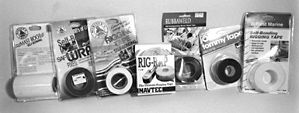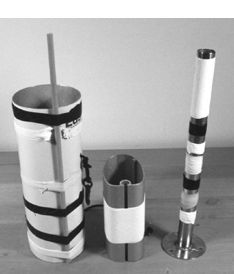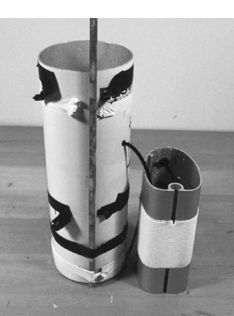It’s called elastomeric self-bonding or self-amalgamating tape.

Elastomeric means that it resembles rubber.
Self-bonding means that it sticks to itself, but it’s an incomplete description. It’s not really very sticky to the touch.
Amalgamating—meaning that it merges into a single body—is the best term to describe a tape that morphs into a solid glob.
The stuff is plastic. It’s activated by stretching. The stretching releases a chemical plasticizer, which permeates the built-up layers of tape and converts it to a solid. It likes to be stretched a lot, to burst all of the tiny bubbles of chemical.
It works best if not allowed to sit around unused for months because the gas tends to migrate out, leaving you with a pretty useless roll of something-or-other.
How easy are these tapes to apply, how well do they work and how long do they last?
What We Tested
First we rounded up the usual suspects. Three of the seven are from Mariner’s Choice.
Mariner’s Choice Mast Boot is a 4″-wide roll 40″ long (unstretched) that would do to wrap one mast base. Because the tape is wide and difficult to grasp and stretch, it would be best to have a helper to apply it; try it alone and that basic truth will immediately emerge. It’s a nice flat white color.
The other six samples are 1″ wide, easy enough to apply, although stretching and getting the first wrap overlapped (as the instructions suggest) before beginning the spiral, requires a bit of digital dexterity.
Mariner’s Choice Rigging Tape (a 15′ roll), comes white or black. It appears to be the same as the Mast Boot. The package describes it as useful for rope ends and chafe protection.
Mariner’s Choice Safety Wrap is presented as a fix for leaky hoses and an alternative electrical wrap. “Water tight and air tight to 100 psi Plus,” say the instructions. This black tape is separated by a thin white plastic backing, which suggests that it contains more of that chemical plasticizer. The roll has 15′ of unstretched tape. The instructions contain directions for making a temporary repair on a broken fan belt, but it seems a dubious undertaking.
Navtec’s Rig-Rap—”The Ultimate Rigging Tape” heralds the container—is white, and the roll contains a generous 36′. The thin tape, which has a thicker ridge down the centerline to make spiral wrapping easier (it does), is separated by a clear plastic backing that is easy to deal with. On the box is the statement, “Not affected by sun…doesn’t dry up or deteriorate.” We’ll see.
Rubbaweld, from Simpson Lawrence, is inch-wide tape, but the package doesn’t say how much is on the roll. We unrolled it and got 16′, unstretched. Simpson Lawrence says Rubbaweld is waterproof and good for all the usual tasks: electrical, turnbuckles, leaking hoses, mast boots, chafe protection and insulation.
The black Rubbaweld is on a thin, plastic backing, also black, that will try your patience, eyesight, touch and vocabulary. We tried all the tricks we know, including stretching, and a partial slit and a fingernail. Suffice to say: Once you establish a separation, don’t lose it!
Tommy Tape comes in a number of versions: white, black, light, medium and heavy duty, flat, and ridged down the centerline (like Rig-Rap). It has a clear plastic strip that, because it’s wider than the tape, is easy to separate. It comes in rolls all the way from 10′ to 36′ and is seen in hardware and auto parts stores.

Tommy Tape is the only one of our samples that in the larger rolls lists full specifications and properties. These include a temperature range (65°C-260°C/-85°F-500°F), dielectric strength and constant figures, volume resistivity, water absorption and shelf life. On request, Tommy Tape will supply tensile strength figures, duro hardness, tear resistance, ultimate elongation and dissipation factors.
West Marine’s “Self-Bonding Rigging Tape” appears to be the same as Mariner’s Choice. (Mariner’s Choice tape is made in Canada; West Marine’s package says “Made in Canada for West Marine.” West’s tape, available only in white in 15′ rolls, is very heavy, very stretchy and has a transparent backing that is almost as difficult as the Rubbaweld. It costs $8.39—60¢ cheaper than Mariner’s Choice’s rigging tape.
Twisting in the Sun
Mariner’s Choice mast boot tape was applied to a short section of 4″ aluminum mast with a slot for a bolt rope. Most of the tape makes direct contact with the anodized aluminum (except for the sail slot).
For the other six samples, generous applications of each tape were placed on a short piece of cylindrical powder-coated aluminum. (It was, as a matter of fact, a bit of tubing sent several years ago by Henry Keene of Edson while Practical Sailor was testing radar mounts. Keene, who is proud of Edson’s powder coating, wrote on it, “Paint test by Hank. Please hit me with your hammer.”)
However, because air, water and dirt can get under tape when used on turnbuckles or electrical wire, a 1/4″ wooden dowel was included under the wrap on Hank’s cylinder.
The mast section and the tubing then were suspended from a piece of small stuff and hung outdoors on the outer end of a tree limb. The shape of the aluminum pieces, dangling from a small cord, encouraged them to revolve almost continually, like a Calder mobile. This gives all parts of each kind of tape even exposure.
The pieces were first exposed in early February, placing the tape at the mercy of some New England cold, snow and sleet as well as rain, sun and temperature changes.
A month later, no change was detectable.
By April, two months into the test period, the tape seemed to be drying out. It felt harder, less sticky and less rubbery.
At the May checkpoint, the three-month mark, the band of white Mariner’s Choice Rigging tape on Hank’s cylinder parted at the point where it passed over the wooden dowel.

To check the impression that all of these tapes were getting harder and less elastic, fresh tape was applied to a piece of stainless steel tubing and compared to the exposed samples. A simple finger nail was all that was needed to indicate clearly that something was happening to the tape.
In June, after getting baked by early summer sun, all of the tapes seemed even dryer and harder—but nothing untoward had happened.
At the five-month mark, the black Simpson-Lawrence Rubbaweld had started to part at the dowel, as shown in the photo. The Rubbaweld felt like it was getting gummy rather than rubber-like.
The others were getting harder.
The ones that seemed to retain the most elasticity were the Navtec Rig-Rap and the Tommy Tape.
Brought in for inspection on Sept. 7, seven months after being exposed to outdoor living, the Simpson-Lawrence Rubbaweld was close to failure—it soon thereafter parted where it passed over the dowel.
In addition, the Navtec Rig-Rap was about half parted, which suggested that it would be next to fail. It did so in a couple of weeks.
Not counting the Mariner’s Choice Mast Boot, which contains a lot of material, that made it three down, three to go.
Brought in at the nine-month mark (early November), these samples can be said to have been exposed for one sailing season in northern climes. In more tropical areas, they probably would, like most materials, have suffered greater deterioration.
The tapes that might, therefore, be called “sure fire” for at least one season are the Mariner’s Choice Safety Wrap, the Tommy Tape and West Marine’s Rigging Tape.
The test was ended at the 12-month mark. The little table embedded on p.19 summarizes what happened. The failures, like those described above, involved the tape parting at the wood dowel or at the top of the slot on the piece of mast. With further exposure, the narrow varieties of tape lose their grip and peel off.
The Bottom Line
If these tapes had been used for below-deck repairs, like taping electrical connections or attaching the emergency tiller to a bulkhead or some out-of-the-way piping, the results probably would have been different. Everything lasts longer if kept out of the elements, especially the sun.
Practical Sailor’s outdoor exposure test suggests that the best tape lasts four times as long as the worse. Of the six kinds of narrow tape (with the mast boot version omitted), the two best-in-the-test were Tommy Tape and West Marine Rigging Tape.
The price of these tapes is not much of an issue, except perhaps for the Mariner’s Choice Mast Boot. It comes in two sizes—40″ for about $20 and 100″ for about $30.
The narrow stuff ranges from about 45¢ to 60¢ a foot. That may seem somewhat expensive. But because the tapes stretch five to six times their initial length, real costs become close to negligible. A 15′ roll might run $8 or $9. The cost can be worked down to 25¢ a foot by buying a 100′ roll, but without a lot of projects you’d be hard put to use it up before it loses its unique amalgamating quality.
Tommy Tape carries the lowest price. It’s not a “marine” product; it’s available in hardware stores. It occupies the unique position, not often seen in Practical Sailor’s testing, of being not only tied for the best in the test, but also the Best Buy.
Contact- Mariner’s Choice, 6219 Monita St., Long Beach, CA 90803, 562/598-5861, fax 562/430-8377. Navtec, 351 New Whitfield, Guilford, CT 06437-0388, 203/458-3163, fax 203/458-9291, email info@navtec. Simpson-Lawrence, 6208 28th St. E., Bradenton, FL 342203-4123, fax 941/746-7166. Tommy Tape, Box 555, Palm City, FL 34991, 561/223-1991, fax 561/223-1995.West Marine, 500 Westridge, Watsonville, CA 95077-0507, 800/937-8895. fax 205/581-9447.
Also With This Article
Click here to view Exposure Results.
































